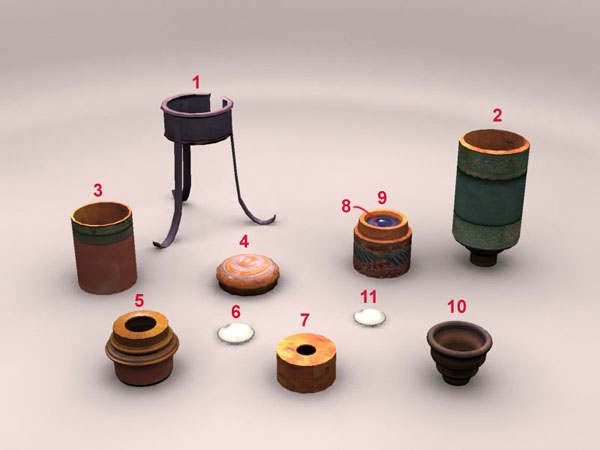 |
Components
| 1 |  |
Support |
| 2 |  |
Body-tube |
| 3 |  |
Retractable tube |
| 4 |  |
Eyepiece guard |
| 5 |  |
Eyepiece holder Boxwood cap with internal and external thread. The internal thread serves to fasten the eyepiece holder to the retractable optical tube, while the protective cap screws onto the external one. The lens is inserted in the eyepiece holder, positioned 6 mm from the outer edge. |
| 6 |  |
Eyepiece The eyepiece is the lens (or system of lenses) through which the eye observes the image formed by the objective. In its simplest form, the eyepiece consists of a single converging lens of short focal length. This microscope has a biconvex lens with some bubbles in the glass. |
| 7 |  |
Diaphragm |
| 8 |  |
Field lens The field lens is used to augment the visual field. This microscope has a biconvex lens placed at a distance of 70 mm from the eyepiece and inserted in a small mobile cylinder. The glass is amber-green, with air bubbles: it has a ground edge that is chipped. |
| 9 |  |
Field lens cylinder The mobile cylinder that houses the field lens rests on the bottom of the body-tube. It can be used correctly in one direction only, that is, with the section bearing the lens turned toward the eyepiece. It can also be removed and used alone, as a simple microscope. |
| 10 |  |
Nosepiece Made of boxwood, the nosepiece is shaped like an upside-down truncated cone. The larger base serves as support for the cylinder housing the field lens. Like the eyepiece holder, the nosepiece was fitted with a protective cap, now missing. |
| 11 |  |
Objective The objective is the lens positioned closest to the object observed, of which it forms a magnified image. The objective in this microscope consists of a biconvex lens whose glass has a high degree of transparency and few flaws; the edge is ground and is slightly chipped in places. |
| ©2007 IMSS · Piazza dei Giudici 1 · 50122 Florence · ITALY |